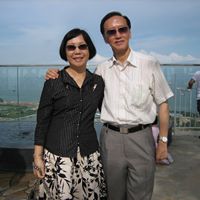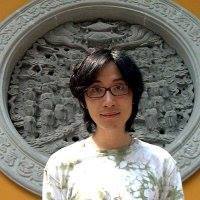Guang N Chen
age ~68
from Oakland, CA
- Also known as:
-
- Guang H Chen
- Guangning N Chen
- Ning Chen Guangning
Guang Chen Phones & Addresses
- Oakland, CA
- Seattle, WA
- Alameda, CA
Us Patents
-
Chemical Arrays And Methods Of Producing The Same
view source -
US Patent:20050233337, Oct 20, 2005
-
Filed:Apr 19, 2004
-
Appl. No.:10/828357
-
Inventors:Bill Peck - Mountain View CA, US
Eric Leproust - San Jose CA, US
David Adaskin - San Jose CA, US
Guang Chen - San Jose CA, US
William Chesk - San Jose CA, US
Donald Schremp - San Jose CA, US
Stanley Woods - Cupertino CA, US -
International Classification:C12Q001/68
C12M001/34
B05D003/00 -
US Classification:435006000, 435287200, 427002110
-
Abstract:Methods and devices for fabricating a chemical array are provided. Embodiments include determining a chemical array layout in which each feature in the layout has a size that is chosen based on its composition and fabricating a chemical array according to the chemical array layout. In certain embodiments, at least two features of an array fabricated according to the subject methods are of different sizes. Embodiments also include chemical arrays having features of different sizes, e.g., fabricated according to the subject methods. Also provided are embodiments that include fluid deposition devices capable of fabricating chemical arrays having features of different sizes, e.g., for use in practicing the subject methods. Algorithms present on computer readable mediums for use in practicing the subject methods may also be provided in certain embodiments. Embodiments of the subject invention may also include systems and kits for use in practicing the subject methods.
-
Dynamic Power Load Line By Configuration
view source -
US Patent:20220335190, Oct 20, 2022
-
Filed:Jul 1, 2022
-
Appl. No.:17/856776
-
Inventors:Guang Chen - Fremont CA, US
Yuet Li - Fremont CA, US
Archanna Srinivasan - San Jose CA, US -
International Classification:G06F 30/347
-
Abstract:Systems or methods of the present disclosure may provide for determining a load line for operation of a programmable logic fabric where the load line is based at least in part on design configuration details for a design or a configuration rather for generic deployment of the programmable logic device. The load line may be determined using software modeling for the design or configuration. Additionally or alternatively, the load line may be determined using runtime testing and sensing of real-world parameters. This determination based on real-world parameters of a deployment of the configuration or design is based on a determination of a step load for the design or configuration.
-
Circuits And Methods For Detecting Decreases In A Supply Voltage In An Integrated Circuit
view source -
US Patent:20210313989, Oct 7, 2021
-
Filed:Jun 21, 2021
-
Appl. No.:17/353549
-
Inventors:- Santa Clara CA, US
Guang Chen - Fremont CA, US
Venu Kondapalli - San Jose CA, US -
Assignee:Intel Corporation - Santa Clara CA
-
International Classification:H03K 19/1778
H03K 21/08 -
Abstract:An integrated circuit includes a first voltage decrease detection circuit that has a first comparator circuit that compares a supply voltage in the integrated circuit to a threshold voltage to generate a first detection signal that indicates a decrease in the supply voltage, and a first timestamp storage circuit that stores a first timestamp in response to the first detection signal indicating the decrease. The integrated circuit includes a second voltage decrease detection circuit that has a second comparator circuit that compares the supply voltage to the threshold voltage to generate a second detection signal that indicates the decrease, and a second timestamp storage circuit that stores a second timestamp in response to the second detection signal indicating the decrease. The integrated circuit includes a control circuit that determines a location of a source of the decrease in the integrated circuit based on the first and the second timestamps.
-
Method For Automatically Labeling Objects In Past Frames Based On Object Detection Of A Current Frame For Autonomous Driving
view source -
US Patent:20210004643, Jan 7, 2021
-
Filed:Jul 2, 2019
-
Appl. No.:16/460192
-
Inventors:- Sunnyvale CA, US
Guang CHEN - Sunnyvale CA, US
Weide ZHANG - Sunnyvale CA, US
Yuliang GUO - Sunnyvale CA, US
Ka Wai TSOI - Sunnyvale CA, US -
International Classification:G06K 9/62
G06K 9/00 -
Abstract:A list of images is received. The images were captured by a sensor of an ADV chronologically while driving through a driving environment. A first image of the images is identified that includes a first object in a first dimension (e.g., larger size) detected by an object detector using an object detection algorithm. In response to the detection of the first object, the images in the list are traversed backwardly in time from the first image to identify a second image that includes a second object in a second dimension (e.g., smaller size) based on a moving trail of the ADV represented by the list of images. The second object is then labeled or annotated in the second image equivalent to the first object in the first image. The list of images having the labeled second image can be utilized for subsequent object detection during autonomous driving.
-
Method For Autonomously Driving A Vehicle Based On Moving Trails Of Obstacles Surrounding The Vehicle
view source -
US Patent:20200406893, Dec 31, 2020
-
Filed:Jun 28, 2019
-
Appl. No.:16/457847
-
Inventors:- Sunnyvale CA, US
Guang CHEN - Sunnyvale CA, US
Weide ZHANG - Sunnyvale CA, US
Yuliang GUO - Sunnyvale CA, US
Ka Wai TSOI - Sunnyvale CA, US -
International Classification:B60W 30/095
B60W 30/09
G06K 9/00
G05D 1/00 -
Abstract:During the autonomous driving, the movement trails or moving history of obstacles, as well as, an autonomous driving vehicle (ADV) may be maintained in a corresponding buffer. For each of the obstacles or objects and the ADV, the vehicle states at different points in time are maintained and stored in one or more buffers. The vehicle states representing the moving trails or moving history of the obstacles and the ADV may be utilized to reconstruct a history trajectory of the obstacles and the ADV, which may be used for a variety of purposes. For example, the moving trails or history of obstacles may be utilized to determine lane configuration of one or more lanes of a road, particularly, in a rural area where the lane markings are unclear. The moving history of the obstacles may also be utilized predict the future movement of the obstacles, tailgate an obstacle, and infer a lane line.
-
Method For Determining Anchor Boxes For Training Neural Network Object Detection Models For Autonomous Driving
view source -
US Patent:20200410252, Dec 31, 2020
-
Filed:Jun 28, 2019
-
Appl. No.:16/457820
-
Inventors:- Sunnyvale CA, US
Tae Eun CHOE - Sunnyvale CA, US
Yuliang GUO - Sunnyvale CA, US
Guang CHEN - Sunnyvale CA, US
Weide ZHANG - Sunnyvale CA, US -
International Classification:G06K 9/00
G06K 9/62 -
Abstract:In one embodiment, a set of bounding box candidates are plotted onto a 2D space based on their respective dimension (e.g., widths and heights). The bounding box candidates are clustered on the 2D space based on the distribution density of the bounding box candidates. For each of the clusters of the bounding box candidates, an anchor box is determined to represent the corresponding cluster. A neural network model is trained based on the anchor boxes representing the clusters. The neural network model is utilized to detect or recognize objects based on images and/or point clouds captured by a sensor (e.g., camera, LIDAR, and/or RADAR) of an autonomous driving vehicle.
-
Determining Vanishing Points Based On Lane Lines
view source -
US Patent:20200410255, Dec 31, 2020
-
Filed:Jun 28, 2019
-
Appl. No.:16/457557
-
Inventors:- Sunnyvale CA, US
Tae Eun Choe - Sunnyvale CA, US
Ka Wai Tsoi - Sunnyvale CA, US
Guang Chen - Sunnyvale CA, US
Weide Zhang - Sunnyvale CA, US -
International Classification:G06K 9/00
G06T 7/536
G06N 3/08
G06K 9/62 -
Abstract:In some implementations, a method is provided. The method includes obtaining an image depicting an environment where an autonomous driving vehicle (ADV) may be located. The image comprises a plurality of line indicators. The plurality of line indicators represent one or more lanes in the environment. The image is part of training data for a neural network. The method also includes determining a plurality of line segments based on the plurality of line indicators. The method further includes determining a vanishing point within the image based on the plurality of line segments. The method further includes updating one or more of the image or metadata associated with the image to indicate a location of the vanishing point within the image.
-
Method For Detecting Closest In-Path Object (Cipo) For Autonomous Driving
view source -
US Patent:20200410260, Dec 31, 2020
-
Filed:Jun 28, 2019
-
Appl. No.:16/457719
-
Inventors:- Sunnyvale CA, US
Yuliang GUO - Sunnyvale CA, US
Guang CHEN - Sunnyvale CA, US
Weide ZHANG - Sunnyvale CA, US
Ka Wai TSOI - Sunnyvale CA, US -
International Classification:G06K 9/00
G06T 11/20
G05D 1/00
G05D 1/02
B60W 30/09 -
Abstract:In one embodiment, in addition to detecting or recognizing an actual lane, a virtual lane is determined based on the current state or motion prediction of an ADV. A virtual lane may or may not be identical or similar to the actual lane. A virtual lane may represent the likely movement of the ADV in a next time period given the current speed and heading direction of the vehicle. If an object is detected that may cross a lane line of the virtual lane and is a closest object to the ADV, the object is considered as a CIPO, and an emergency operation may be activated. That is, even though an object may not be in the path of an actual lane, if the object is in the path of a virtual lane of an ADV, the object may be considered as a CIPO and subject to a special operation.
Name / Title
Company / Classification
Phones & Addresses
President
HONG TUO STONE PRODUCTS, INC
Whol Brick/Stone Material
Whol Brick/Stone Material
237 10 St, Oakland, CA 94607
2493 Washington Ave, San Leandro, CA 94577
1355 Pearson Ave, San Leandro, CA 94577
2493 Washington Ave, San Leandro, CA 94577
1355 Pearson Ave, San Leandro, CA 94577
Yoppi Yogurt LLC
Trademark Owner · Whol Dairy Products
Trademark Owner · Whol Dairy Products
1815 Ygnacio Vly Rd, Walnut Creek, CA 94598
7836 Pineville Cir, Hayward, CA 94552
7836 Pineville Cir, Hayward, CA 94552
President
PING YUEN RESIDENTS IMPROVEMENT ASSOCIATION
Civic/Social Association
Civic/Social Association
799 Pacific Ave, San Francisco, CA 94133
4157812860
4157812860
President
NEW ART STONES INC
1257 Terra Ave, San Leandro, CA 94578
Resumes

Software Engineer At Broadcom
view sourceLocation:
San Francisco Bay Area
Industry:
Consumer Electronics

Associated Director Biostatistics
view sourceLocation:
P/O Box 1027, Millbrook, AL
Industry:
Biotechnology
Work:
Amgen
Senior manager
OmniViz 2001 - 2005
Lead Statistician
Senior manager
OmniViz 2001 - 2005
Lead Statistician
Skills:
Financial Services
Consulting
System Integration
Consulting
System Integration

Guang Chen
view source
Application Architec At First Data Corporation
view sourceLocation:
United States
Industry:
Financial Services

Guang Chen
view sourceLocation:
United States
Googleplus

Guang Chen
Education:
Columbia College of Columbia University in the City of New York - Mechanical Engineering, Shanghai Jiao Tong University - Mechanical Engineering

Guang Chen

Guang Chen

Guang Chen

Guang Chen

Guang Chen
Tagline:
Liberte, egalite, fraternite.

Guang Chen

Guang Chen
Tagline:
Take your passion and make it come true.
Youtube
Myspace
Plaxo

Chen Guang
view sourcechina
Flickr
Classmates

Guang Hui Chen
view sourceSchools:
Anacortes High School Anacortes WA 2000-2004
Community:
Tina Masters, Julie Stewart, Geri Brantly

Manhattan Comprehensive N...
view sourceGraduates:
Wei Guang Chen (1998-2000),
James Barlow (1990-1991),
Joseph Adorisio (1997-1997),
Michelle James (2001-2001),
Wilnelia Cardona (1997-2000)
James Barlow (1990-1991),
Joseph Adorisio (1997-1997),
Michelle James (2001-2001),
Wilnelia Cardona (1997-2000)

Guang Chen
view source
Guang Chen
view source
Guang Chen
view source
Guang Z. Chen
view source
Yu Guang Chen
view source
Guang Chen
view source
Guang Chen
view source
Chen Wei Guang
view sourceGet Report for Guang N Chen from Oakland, CA, age ~68














